The “yellow jackets” are rioting in France. God only knows what is coming for us in 2020. America seems to be cozying up with the idea of civil unrest. You could even make the argument that rubble will be the biggest resource on the world stage.
It’s easy to understand how, without a major disaster, we could find ourselves slowly slipping into a collapsed society where commerce has failed, and the buildings are hollowed out from flame.
This brings us to the topic of this article. In a bleak future like the one I mentioned, dealing with cooking and heating your home in the winter will be a challenge. If we sit idly by and watch the world descend into chaos, we won’t have the convenience at our fingertips.
I set out to play around with the creation of a super simple, heating and cooking system from as few items as possible. The goal was to see if I could both heat a room and boil water with a super simplistic improvised heater.
The results were very interesting, to say the least.
Where I Started
The fuel source was vegetable oil. While cooking oil is not an abundant prep in most people’s homes, it can be used to make candles and lanterns. It works quite well if you construct something like a vegetable oil lantern. This was step number one for me.
Vegetable Oil Candles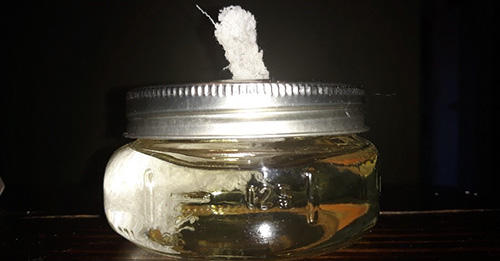
I thought it best to create these candles as a scavenged item as well. Using 4oz ball jars I simply punctured the lid and then fed a torn, oil soaked, wash cloth through the lid. Then I filled the jar with vegetable oil and secured the lid. These would be my heat sources for the experiment.
Related: How To Make Survival Lamps With Used Cooking Oil and Mason Jars
The Heater
There were only two other components to this build. The first were the concrete bricks and the second was the cookie sheet.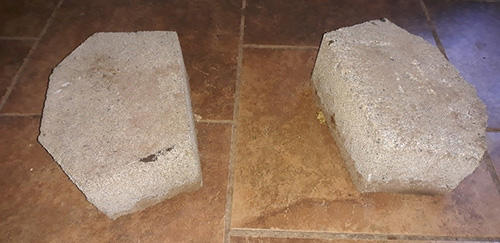 I used a cookie sheet because I was interested in something that would pass heat through it easily. The goal was not just to heat the room but also to see how much heat we could create in order to possibly boil water. I felt using thicker steel or cast iron would be counter productive because my heat output was very limited.
I used a cookie sheet because I was interested in something that would pass heat through it easily. The goal was not just to heat the room but also to see how much heat we could create in order to possibly boil water. I felt using thicker steel or cast iron would be counter productive because my heat output was very limited.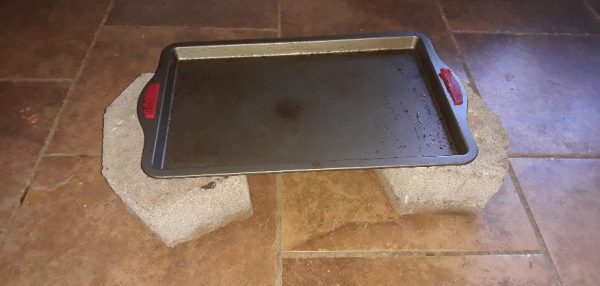 It should be noted that I also tried this experiment with a Crisco candle and it woefully underperformed. I wasn’t surprised considering the small amount of heat they produce. They are really a light source and not much else. Still, it colored my expectations of how it would go with these vegetable oils candles. I was expecting much less than what I got.
It should be noted that I also tried this experiment with a Crisco candle and it woefully underperformed. I wasn’t surprised considering the small amount of heat they produce. They are really a light source and not much else. Still, it colored my expectations of how it would go with these vegetable oils candles. I was expecting much less than what I got.
Related: How To Make Your Own Solar Water Heater
The Experiment
After soaking the torn wash cloth pieces in oil overnight, they went up instantly. The flame and the heat off these larger “wicks” was astounding. In fact, they started burning the Teflon from the bottom of the cookie sheet and in moments I had to open the door to let out the black smoke. I am sure those fumes will come back to haunt me in my later years.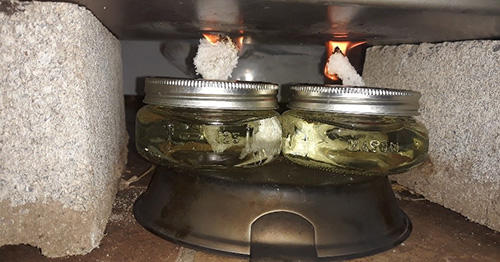 Needless to say, the candles overperformed and in a matter of seconds the heat was not just coming out from under the heater but also emanating through the cookie sheet. The flames were directly touching the metal and it was causing some dark spots to appear through the metal. By this point I felt very confident in this build and its ability to heat this already warm room.
Needless to say, the candles overperformed and in a matter of seconds the heat was not just coming out from under the heater but also emanating through the cookie sheet. The flames were directly touching the metal and it was causing some dark spots to appear through the metal. By this point I felt very confident in this build and its ability to heat this already warm room.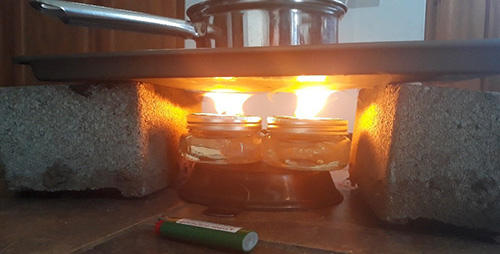 If I were in a room that was 40-50 degrees, the heat coming from this setup would have been like a dream.
If I were in a room that was 40-50 degrees, the heat coming from this setup would have been like a dream.
Related: 7 Primitive Cooking Methods You Still Need to Know Today
The Water
Once the wicks burnt down a bit and the oil candles seemed to reach stasis I decided to move forward with the effort of boiling water. I grabbed a saucepot with a thin bottom and added just 1\4 cup of water, about. I wanted to use a very small amount because I knew that would boil fastest. After about 10 minutes the water was warm, but it wasn’t hot. Though the heat was very strong through the sheet and coming from the sides of the heater it didn’t seem to have enough gusto to bring the water to a boil.
After about 10 minutes the water was warm, but it wasn’t hot. Though the heat was very strong through the sheet and coming from the sides of the heater it didn’t seem to have enough gusto to bring the water to a boil.
That was when I decided to give the water a helping hand. I brought the small amount to a rapid boil and then placed it back on the heater. My hope was that it would slow at first but heat back up in a hurry. No. It didn’t even simmer. The amount of heat needed to boil water is a lot more than you might expect.
This makes those gasifier camping stoves even more impressive!
I left the heater on for about 20 more minutes and when out on the back-stoop wit the door open. Thankfully it was a very cold day out and frost was still clinging to the leaves tucked away in the shadows. I wanted to get cold. I wanted my hands to turn red, so I could experience the heat of this contraption coming in form out of the cold. It didn’t take long.
The true value of this heater shown through when I came back in from the cold. Hovering my hands over the metal was like warming them over a radiator. That is what it reminded me of most. That type of emanating heat was produced through the cookie sheet.
The sheet was beginning to warm from the heat and I don’t know how many times you could use this piece of metal but at that point I removed it and snuffed the candles out.
I truly underestimated the power of these vegetable oil lamps, lanterns, candles or whatever they are. This setup, however crude, is effective. I feel like you could scavenge something like this in the worst of scenarios.
At its core it’s a couple rocks, a scrap of metal, some torn cloth, two containers and oil to fuel it all. Even in a home heated at 70 degrees the heat was apparent, if you were freezing in a hollowed-out shelter in an urban collapse this thing would be like a dream.
You may also like:
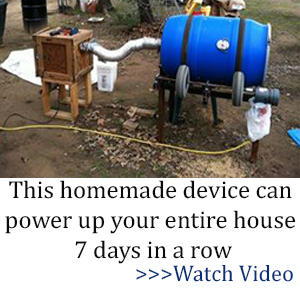 How to Make Your Own Semi-Automatic Off the Grid Washing Machine (No Electricity)
How to Make Your Own Semi-Automatic Off the Grid Washing Machine (No Electricity)
Arizona Farmer Accidently Discovers Trick to Turn Air into Water (Video)

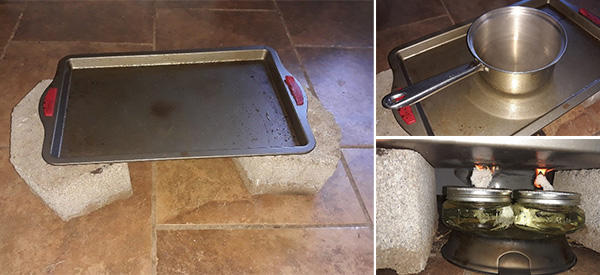













This adds another dimension to prepping cooking oil since it has a relatively short shelf life. I’d be curious about what kind of gasses it produces as a byproduct. Hopefully no high concentrations of poisonous ones. Thanks for writing this.
Good idea for used cooking oil. Recycle!!!!!
Only downside is the smell of French fries…
This experiment parallels experiments I did with a variety of different vegetable oils; olive oil, canola oil, corn oil, a bottle marked “vegetable oil”, sunflower oil. I didn’t use avocado oil or walnut oil — too expensive.
I used a tuna fish can and filled the can with cardboard cut to fit inside the can so that it would hold the wick up. I found all of the different oils I tried burned about the same amount of time. A tuna fish can filled with rolled up cardboard and then filled with oil would burn all day long. For a wick I used the neck hem of a 100% cotton t-shirt.
A lamp thus constructed is very smokey and would soon darken the inside of at least the room where burned with soot. Some research on line indicated that in regions where cooking oil is used for lighting purposes, lung problems, especially among the young are endemic. So there is that to consider. Short term, it would be okay, but based on my experiments, I decided that cooking oil lamps would be a deep fall back source of light for me.
Interestingly enough, as I have indicated previously, NHKTV with the backing of the Japanese government has PSA spots where they teach emergency backups. Just this week they had an emergency stove made out of an aluminum soda can. They cut the can so that it was about an inch and a half high and discarded the top piece. They didn’t fill it with cardboard as I did. They used aluminum foil, folded it, punched small holes through it to insert kite string as wicks. They used three pieces of kite string as wicks. They then folded the aluminum foil so that the wicks stuck up about an inch above the lip of the can. They added oil to the can. They then cut three more aluminum cans about an inch taller than the can with the wicks and oil. they arranged the three taller cans in a triangle around the lamp. They then placed a pot over the flame. The pot rested on the three cans arranged in a triangle around the flame. I hope my word picture conveys what I am trying to describe. This is the Japanese government’s emergency stove recommendation.
My personal experience with my tin can stoves is that they get too hot to hold. If I were doing this, I would make sure the stove and the cans surrounding it were sitting on some surface that would not scorch or catch fire.
Further research on science.answers.com indicates that it takes 1334 BTUs to raise 1 gallon of water from 40°F to 200°F. Some place else I read that the heat from a single match is roughly equivalent to 1 BTU. As I recall, that datum didn’t indicate whether it was a paper match or a wooden match, but my guess would be a wooden match. It also didn’t indicate how far down the match it had to burn to release one BTU of heat.
In an earlier article posted by Claude, there were instructions on how to make a room heater using two flower pots and a single candle. I don’t remember the name of the article but a search should reveal that article.
In cold weather training we used a single candle to heat our snow caves and our two-man tents. The outside temperature was from -10°F to -20°F. The single candle didn’t make the snow cave or the tent really warm but it made them much warmer than outside. As I recall some 60 years later, the snow cave actually seemed warmer than the 2-man tent. Of course, we were fully clothed inside our sleeping bags, having only removed our mickey mouse boots.
You can make little oil lamps from tuna cans with a cotton ball floating in oil. You light a paper match and lay it on the cotton ball and the match will be the wick. Maybe make little shelves for lamps in room corners backed by mirrors. Not a tremendous amount of heat or light, but if you have several ? You can still get huge amounts of used veggie oil .
I like the prepping posts, I don’t like the advertising teasers with incredibly long videos (even the text versions are too long) before you get hit with the sting. It will cost you blah blah blah. Advertise if you must, but please . . .just get to the point!
I agree with you 100%! They drive me insane AND what is WORSE….. NO WAY TO BYPASS OR OPT OUT! Listen to it all or get nothing. Advertisers have lost a lot of money over those “Long Winded Spiels” I am Sure.
Max,
I am with you, I do NOT need to know the guys life history.
Just give me the information that the teaser claimed was there and keep it short. I am not willing to sit through a 40 minute video that only presents 2-3 minutes of real content.
I hear ya! I can take about 30 seconds of That Voice. Then its zzzzzzzz time.
Interesting experiments. An unused paint can, roll of toilet paper inside (cardboard center removed) filled with 90 % rubbing alcohol. Similar concept. The drawback to cooking is the heatsink (i.e. the cookie sheet). Heatsinks in electronics disperse heat. Now the cookie sheet could be tried for browning meat? You would need a concentrated surface area to produce boiling water. Like leftcoastchuck pointed out, In Japan, they use a coke can. Another coke can could be placed on top with water in it. I haven’t tried this method apart from using it as a candle. However 90% rubbing alcohol flame does boil water. I’ve heard the coast guard uses this method. I’ve enjoyed reading everyones comments.
Well, I don’t have a degree in organic chemistry, but certainly the flame would put out CO which is always a concern in enclosed environments. The problem of CO concentrations was answered in the comments section to an article several months ago: Get a spare CO detector. They are cheap. Install it in a Faraday cage so it will be available in the event of an CMP/CME and use it when you are using any open flame device in your home. Costco had them on sale for $20 in either November or December as did Walmart.
You are certainly correct about what to do with rancid cooking oil — use it for lighting purposes or heating purposes.
I think the biggest problem with oil lamps is the soot from the flame. Outdoors it is not a problem but indoors it may well become a problem.
Have several hanging baskets With plants of any kind… They will give you fresh air and may helps with sut in the air. BACK TO NATURE AND WE SOLVE ALL THE PROBLEMS…
It has been about 30 years since my brother and I owned a boat, but for many years cooking done on a boat was done with an alcohol stove. My 30 year old recollection is that was because an alcohol stove doesn’t generate CO. Please do not rely on my 30 year old recollection. The alcohol used was denatured alcohol rather than isopropyl alcohol. I finished my semester in organic chemistry just before I would have been asked to leave the course for failing. I don’t know if isopropyl has a different chemical chain from denatured alcohol which my father, who used it when doing plumbing to get his torch going, called “wood alcohol.” I always was under the impression that denatured alcohol was grain alcohol or ethanol that had been denatured so folks wouldn’t drink tax free ethanol.
We used 99% isopropyl alcohol in the printing process as it is a wetting agent and assists in maintaining ink/water balance in offset printing. It also burns nicely but there is a definite odor when burning IPA. I haven’t burned denatured alcohol, so can’t say about. it We never cooked on our boat. Labs used to use alcohol lamps for heating chemicals but I have no clue what kind of alcohol it was.
One can still buy alcohol lamps which look much like the devices pictured in the article. Amazon probably has them and another mail order company, Garrett Wade offers alcohol lamps or stoves in their product line.
I experimented with an improvised stove:
I placed 2 bricks down on the ground,
about 12 inches apart, then put a
cookie sheet on them for a flat cooking surface.
Under the cookie sheet, I placed a
tinfoil pie plate, with some crumbled up
paper towels in it, (any paper would do),
then I poured cooking oil over the paper
towels, and lit them.
I put another aluminum pie plate on the
cookie sheet, and I was able to
“fry” eggs in it, and make some toast.
I don’t think it would actually
“cook” vegetables though.
FYI, regarding heat. A kerosene lamp that has a 3/4″ flat wick will produce about 1500 BTU’s. The lamps with a 1/2″ wick will put out about 1000 BTU’s.
Not only does it produce light, it’s a good heater.
BTUs in what time period? Is that a constant 1500 or 1000 or is it in an hour? If the 1,000 was a constant BTU generation that would be 60,000 BTUs per hour which is a lot. I surmise that the amount of heat is 1500 BTUs per hour. 60,000 BTUs per hour would mean that you could be distilling 42 gallons of water an hour over a 1/2″ wick in a lamp.
I don’t remember what the wattage is on my electric water distiller but it takes about 4 hours to distill one gallon of water. I could eventually figure out the math but won’t bother as I think everyone gets the general idea.
I think I answered my question.
This is a BTU output per hour. I wanted to know this because I have a small off grid cabin with solar for light and charging small things like batteries etc. Running 4 Jupiter style Dietz lanterns keeps the 14’x14′ area comfortable during the winter, not to mention the soft mellow light they provide so well. I have the walls and ceiling insulated with fiberglass batting. It’s a tight little space and the 6000 BTU’s I get from the four lamps works well for heat. I’ve been on the lookout for a small wood stove but haven’t come up with anything yet.
I’ve been looking for one also. Please let me know if you find one and where. Thanks, John
John, my search has been and probably will continue to be local through friends.
I’ve seen inexpensive wood burners on the Southern Prepper 1 You tube channel; if I recall they were under $100. He liked them and bought a few more for his community needs within his network of preppers.
Okay, three answer from answer.yahoo.com:
“The ethyl alcohol used in fondue pots is denatured by adding 5% methyl alcohol. This makes it poisonous as far as drinking. It also allows you to buy it without the excise tax charges on grain alcohol products. It is fine for burning. It burns cleanly with out soot or carbon monoxide. It is not toxic to burn, it is toxic to drink.
science teacher · 1 decade ago
“Methylated spirit (Meths or denatured alcohol — but not Rubbing alcohol, which is different [1]) is ethanol which has been rendered toxic or otherwise undrinkable, and in some cases dyed. It is used for purposes such as fuel for spirit burners and camping stoves, and as a solvent. Traditionally, the main additive was 10% methanol, which gave rise to its name, but this is not always the case now. There are diverse industrial uses for ethanol, and therefore literally hundreds of recipes for denaturing ethanol. Typical additives are methanol, isopropanol, methyl ethyl ketone, methyl isobutyl ketone, denatonium, and even (uncommonly) aviation gasoline.
As used in the phrase denatured alcohol, denatured means “a specific property of ethanol, its usefulness as a beverage, is removed”. The ethanol molecule is not denatured in the sense that its chemical structure is altered.
“There is no duty on methylated spirit in most countries, making it considerably cheaper than pure ethanol.
Different additives are used to make it both unpalatable and poisonous in such a way that is hard to rectify through distillation or other simple processes. Methanol is commonly used for this in part because it has a boiling point close to that of ethanol, and separating it by distillation is difficult, but not impossible as methanol and ethanol form a zeotropic mixture (not to be confused with an azeotropic mixture). In many countries, it is also required to be dyed blue or purple with an aniline dye…
Aren’t you sorry you asked the question? You now know way more than you ever wanted to about denatured alcohol and ethanol. AND, I was right. denatured is so people don’t drink untaxed ethanol. Courtesy of our masters in Washington looking out for our well being.
Ok, here’s a question for you, Chuck. I heard, years ago, that bums (that’s what they were called when I was a kid) would take rubbing alcohol and pour it into a loaf of bread, and then they’d drink it. Did you ever hear of this, and would a loaf of bread be capable of filtering out the toxins? Just curious.
Yes, I heard that bums did that back years ago when I was a kid. I haven’t heard that in recent years. To the best of my knowledge, it did not make the alcohol potable. It resulted in blindness and damaged kidneys and liver. Once the denaturing chemical, whether methanol or whatever else is added, I don’t believe it is possible by a simple method to remove the denaturing compound. I think that is also mentioned in the three references I posted above, that the denaturing compound is such that it cannot be removed by either distillation or some other simple method. Stick with EverClear or some other high proof grain alcohol.
Inmates in prison have been known to take hand sanitizer and drip it through salt in a coffee filter to get the alcohol liquid. I haven’t tested this. I heard this from a C.O.
I heard a jail deputy say that the only time he ever got in a bad fight there was when one inmate stole a large bag of hand sanitizer. They poured it in to a trash bag and used one of their coil heaters (for beverages) to heat it up to vaporize the alcohol. They formed the bag crudely in to a kind of horseshoe shape and cooled the other end. They drank what condensed out, and I’m told that was a bad bad night.
please don’t notify me any more with comments .
The alcohol in classic brown Listerine is denatured by the addition of some intensely concentrated herbal extracts, thyme and eucalyptus among them, it won’t kill you but you sure can’t drink the nasty stuff. The dental hygienist who was removing the plaque from my teeth with an old pedal wheel grindstone told me all about it, said if I used the stuff every day I wouldn’t get any more plaque. I started using it, 15 years later i still have very little plaque and have not been back to the dentist. Only brown Listerine is worth stockpiling.
Col. Hackworth in his book About Face tells about his experiences during one of the big winter retreats of the Korean War. They would fight, then walk all day, none of the troops had winter gear beyond sleeping bags, at night if they were lucky they would shelter in abandoned peasant huts. The huts were adobe, our guys discovered that to heat the huts they had been built like rocket stoves, the mud floor of the hut was laid over an adobe fire chamber connected to adobe ducts that led to a chimney. Heated so efficiently the Colonel says guys would burn their gear up stuffing too much wood into the chamber.
Imagine that winter retreat, 0 F and below, windy, humping the mountain roads without proper boots or coats, gun oil keeps freezing the action on your M1, 100,000 screaming Chinese right behind you…
Most alcohol is made from wood,which is deadly if drank.
I’m wondering if the water might have boiled if the pot was directly above the flames. The cookie sheet is going to conduct a lot of heat away from the pot and radiate it into the air. Next time you fire up your lamps try resting the pot directly on the blocks – I’d be interested to know how that works!
The video showing the Japanese stove shows the pot resting on the three other soda cans and the flames from the three kite strings is burning right on the bottom of the pot. I agree, I think the cookie sheet would allow two much heat to be dissipated. It is acting like a huge heat sink.
I’d be curious to see how effective using a terracotta flower pot as the “radiator” instead of the cooking sheet would be. Prop it on the bricks upside down just above or level with the frame. Not sure how it would fair with boiling water, but it wouldn’t release any teflon when it got hot. I think I’ve heard of this being done with tea lights, but I’m sure the vegetable oil candles would be much more effective.
Some time back Claude had an article wherein the author gave the plans for using two terracotta flower pots to make a room heater. He used tea candles if my recollection serves me. I am sure you can find the article if you search through the “how to’s” section. It must have been a year or more back that the article appeared. The arrangement threw a surprising amount of heat. Not enough to heat a McMasion, but enough to keep a single room livable in frigid weather. That’s the best way to survive. Get everybody into a single room, block off all the exits, make sure the windows are covered at night and all the leaks around the doors are sealed off. Be sure to have your CO detector in the room so you don’t wind up killing everybody. Have access to at least one window or door in case the CO detector goes off.
Have several pots ,or hanging baskets with LIVE plants, the more the merrier… They will absorb ALL CO2 and CO ln the room plus some soot… Is if you are outdoor space…BACK TO NATURE…
Well, I was unable to find the article. Claude says he reads all of the posts, so maybe he knows how to find something that far back. Apparently they drop off after a while and aren’t available. At least with my limited web searching skills I was unable to find the article that I referenced.
You can search youtube for them. Flowerpot heater, candle heaters, alternate heat. Something like that
as boy scouts we would take cardboard and roll it tightly then stuff it in a tuna can. then pour paraffin into it this made a very good cooking stove or heater
Inmates in prison have been known to take hand sanitizer and drip it through salt in a coffee filter to get the alcohol liquid. I haven’t tested this. I heard this from a C.O.
Re-reading the posts here, I’m thinking that if you put a container of water, ie a baking pan or chafing dish steam pan directly over the heat source, the water would act as a thermal reserve/dispersion unit. It might have to be topped off during use because of evaporation, but it seems like it would be a good way to heat a room during a power outage. Moist air retains heat better, and winter air is usually very dry.
I just came across an interesting wood stove last week called the Nu-Way. It’s made in Michigan for ice fishermen, and it’s small like an ammo box stove Model 965. It weighs 15 lb, made of 20 gauge steel, and is 12″x7″x15″. The price is $125, plus $20 shipping. If you want warm heat through the night, you might consider their propane stove- Model 2000, which looks a lot like their 965 Wood stove. but configured instead to burn propane only- you can’t simply switch back to wood instead the following weekend. The heat is dry like wood, because the propane is vented, so the moisture goes up the 3 inch stove pipe. Their propane stove weighs 10 lb, is 9 1/2″x7″x15″, and puts out 12K BTU. The price is $190, plus $20 shipping, and comes with a 5 ft hose for a tank, but longer hoses are available. Go to nuway stove dot com.